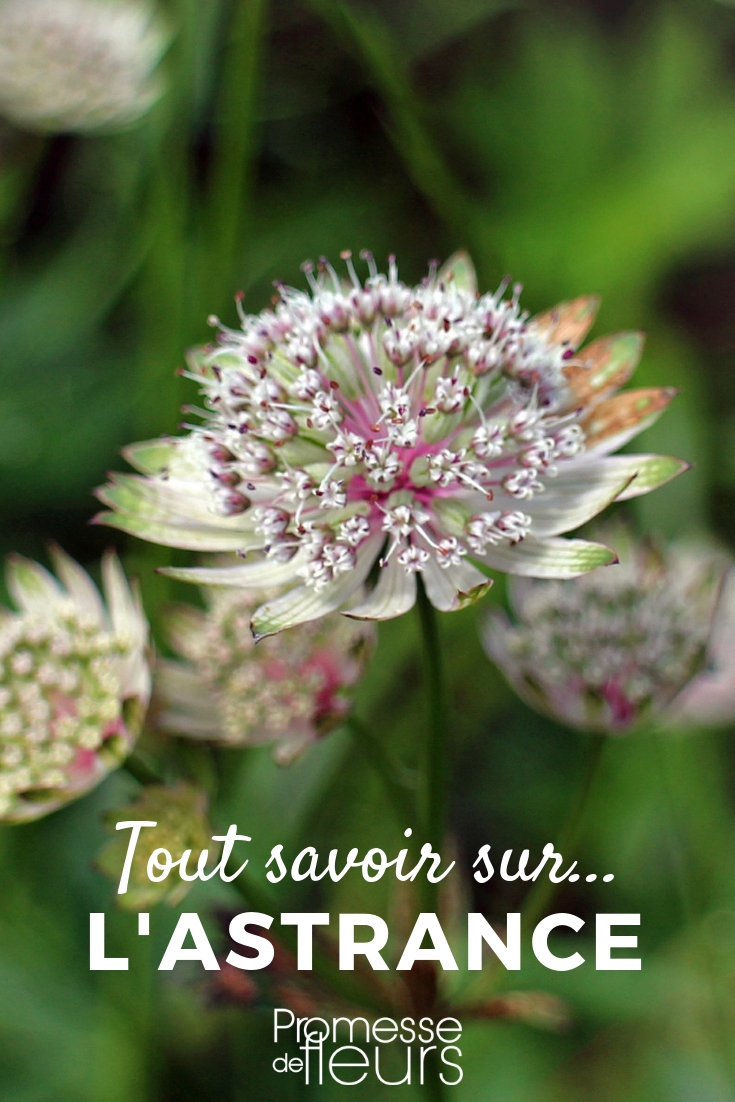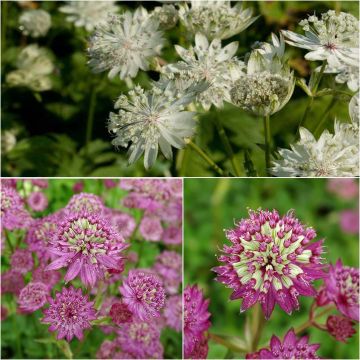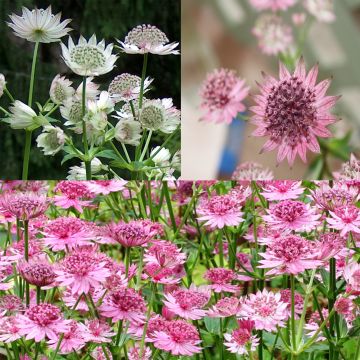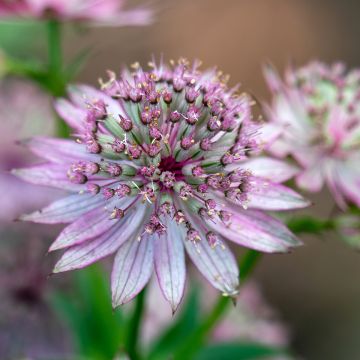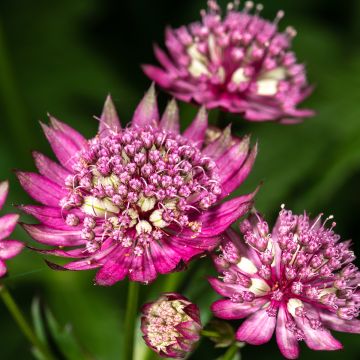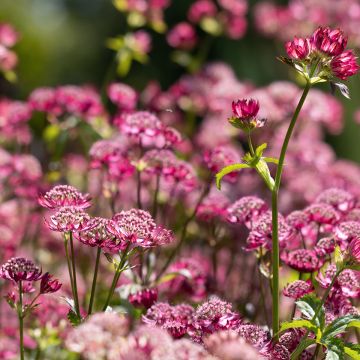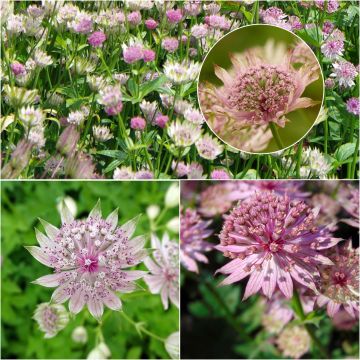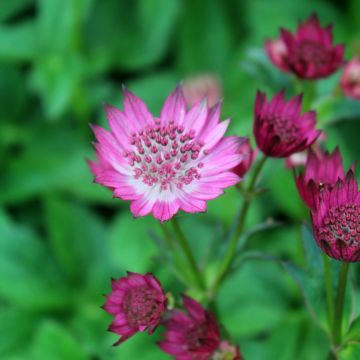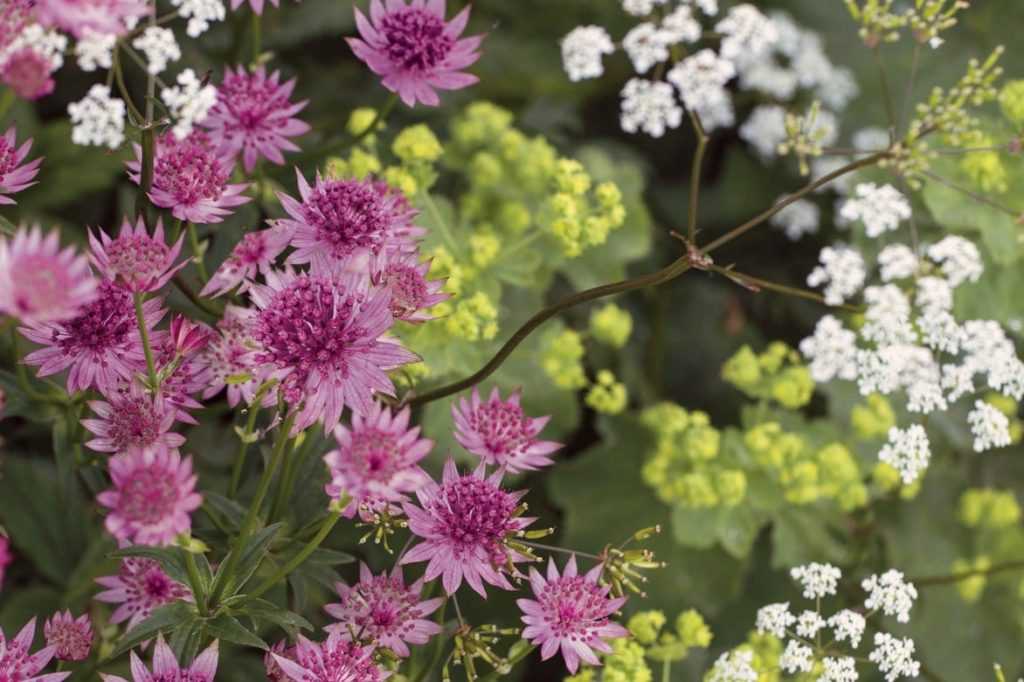
Astrance: plant, care for and combine in the garden
Contents
Astrantias in a nutshell
- Astrantia is the most beautiful of the flowers for partial shade, blooming throughout summer
- Easy to grow, astrantia tolerates all types of soil and only fears summer drought
- It is quite difficult to sow (prefer young plants), but easy to divide
- Wonderful when combined with perennials, grasses, and bushes
- Emblematic of English gardens, an icon for many landscapers… Astrantia is our favourite flower!
A word from our Expert
Great Masterworts (Astrantia major), classics of English gardens and vicarage gardens, very much in vogue with landscapers for prairie-style gardens, are prized for their wild yet sophisticated appearance.
However, they remain largely unknown to the amateur gardener, for whom Astrantia is more synonymous with a (very good) Parisian restaurant.
Masterworts are one of the most beautiful perennial flowers for partial shade: easy to grow, they flower for a long time, throughout summer, in magnificent starry umbels of pink, white, or red depending on the variety.
Astrantia thrives in rich, cool, well-drained soil in partial shade. Very sturdy, this montane plant found at the forest edge and in alpine meadows often takes a year to really get going, but then produces a large clump of dozens of floral stems continuously from June to September. It is only truly threatened by summer drought.
Astrantia is very versatile in the garden. It pairs well with… almost everything, particularly perennials and roses. It makes beautiful, rustic-looking bouquets.
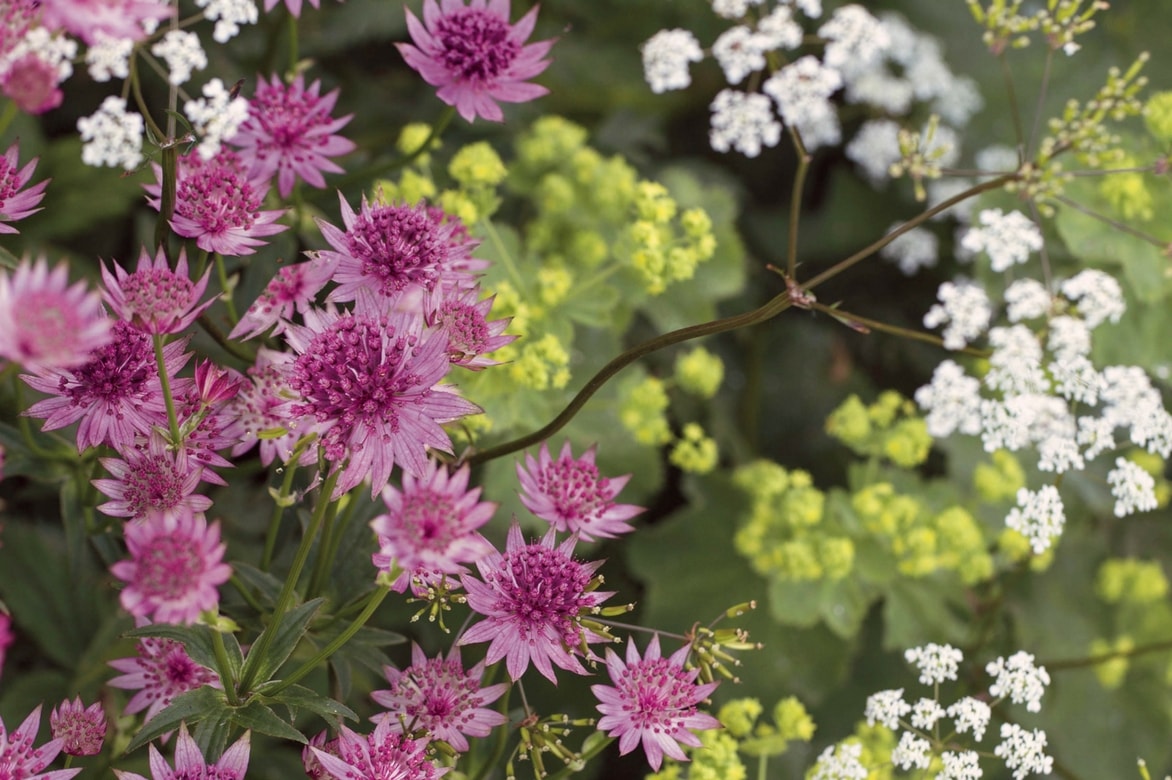
Astrantia major ‘Roma’ – Alchemilla mollis – Anthriscus sylvestris
Botany
Botanical data
- Latin name ”Latin
- Common name ”Common
- Flowering ”Flowering
The leaves, dark green in colour, are palmate in shape, divided into dentate lobes. Some varieties have superb variegated foliage, such as the variety ‘Sunningdale Variegated’.
Astrantia has a fairly dense habit, forming a compact clump of about 40 cm in height and width at maturity. The deciduous foliage appears quite late, generally around the end of March. It begins to fade (blacken) by the end of summer, disappearing entirely by mid-autumn.
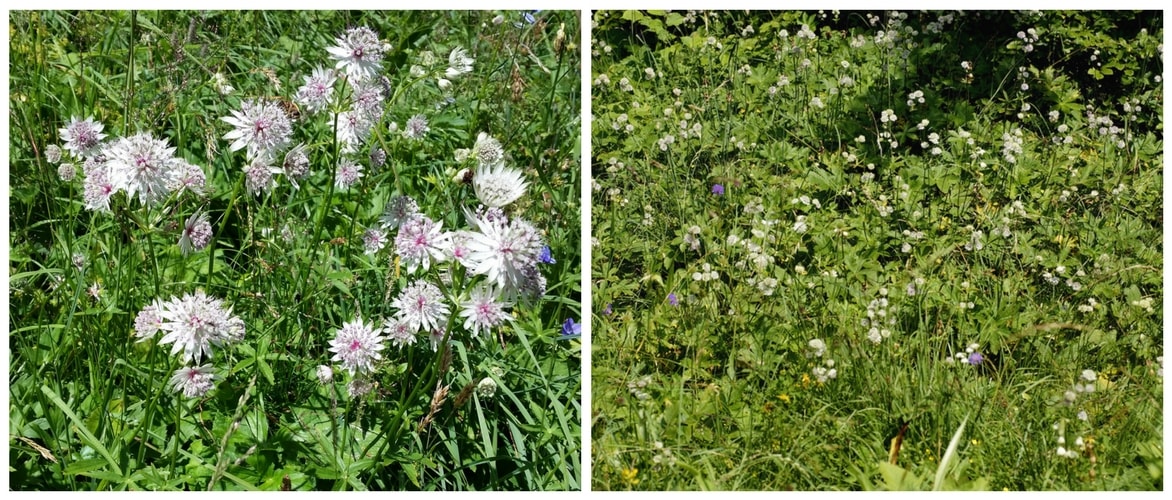
Population of Astrantia major at the forest edge in the Alps
The clump is usually cut back at the base in October, as it is not very attractive in autumn, or in early spring to encourage the emergence of new foliage.

Different foliage of astrantia. From left to right, Astrantia major, Astrantia minor, Astrantia Sunningdale Variegated.
A rhizomatous plant, it has a fairly slow growth. When planted in a bucket, it often flowers in the first year, but will only form a beautiful clump after a year of cultivation. If you sow seeds, you will need to wait at least two years for a good flowering. The clump continues to grow, never becoming invasive. Under favourable conditions, the botanical varieties and some horticultural varieties with white and pink flowers self-seed spontaneously.
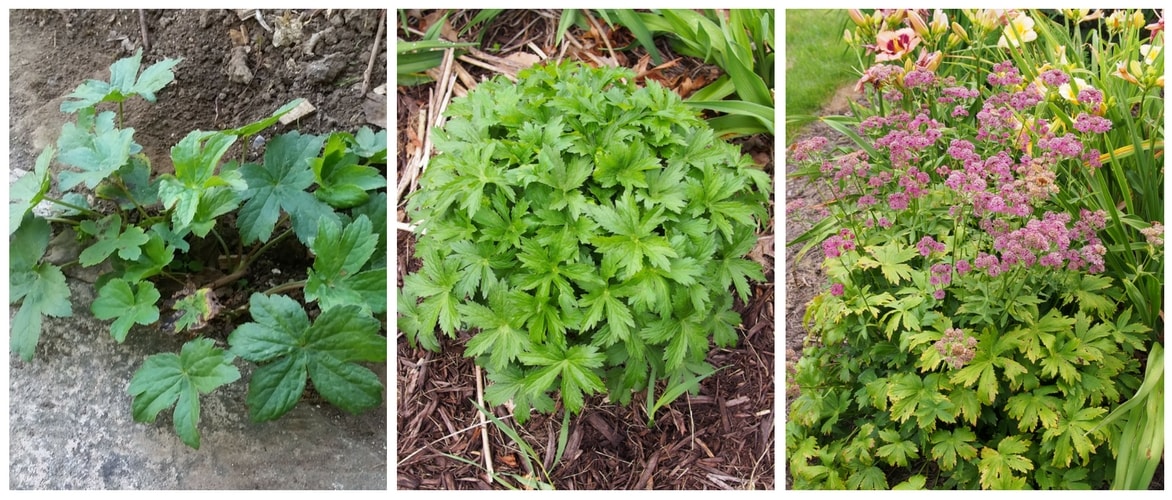 Spontaneous sowing growing between the joints of a paving – Clump of Astrantia in foliage – In bloom after 3 years of planting[/caption>
Spontaneous sowing growing between the joints of a paving – Clump of Astrantia in foliage – In bloom after 3 years of planting[/caption>
It is sometimes said that its lifespan is short, around 5 years. This is false. Some of our mother plants are over 15 years old! Dividing the plants allows them to regain vigour.
The flowers of Astrantia are borne on long stems about 60 cm high (40 cm for the shorter ones, 80 cm for the taller ones), branching upwards into multiple stems, each bearing a flower. The floral stems, sturdy, withstand the elements well; fine and tall, they sway in the wind, forming a small white or pink cloud of several dozen flowers.
The flowers, about 3 cm in diameter, are a small masterpiece of botanical craftsmanship: the finely cut umbel of tiny flowers is bordered by a collar of “petals” (actually leaves, the bracts), shaped like a crown.
 Several stages of development of the simple inflorescence of the Great Astrantia. The bracts at the bottom surround the fertile flowers composed of pistils and stamens.[/caption>
Several stages of development of the simple inflorescence of the Great Astrantia. The bracts at the bottom surround the fertile flowers composed of pistils and stamens.[/caption>
The flowers are generally pink or white tinged with anise green or grey in some varieties. Some cultivars are red leaning towards purple (‘Hadspen Blood’, ‘Moulin Rouge’), and many display colour nuances in a crystalline delicacy.
Flowering usually starts in May or June and ends between July and September. Astrantia flowers for 3, sometimes 5 months! This longevity of the flowers is due to the sturdiness of the floral stems, the flowers that withstand wind and rain well, and the renewal of the floral stems during the summer. Cutting the floral stems and watering in case of drought encourages the resurgence of flowering throughout the summer. The varieties ‘Hadspen Blood’, ‘Star of Billions’, and ‘Roma’ in particular flower quite continuously throughout the summer.
As no one is perfect, Astrantia is not fragrant. However, it is very melliferous and attracts butterflies and pollinators.
Discover astrantias in video with Olivier:
Main varieties
There are dozens of varieties of Astrantias, with differences that sometimes stem more from plant marketing than from actual differentiation. Almost all cultivated varieties are Astrantia major. Occasionally, you can also find Astrantia maxima, which has larger flowers, about 5 cm in diameter, Astrantia carniolica, a low species well-suited to cool rockeries, and Astrantia minor, which has the smallest flowers.
The main selection criteria are flower colour, height, and flowering time.
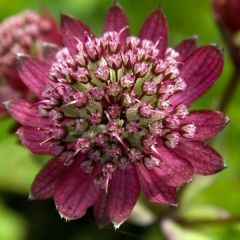
Astrantia major 'Hadspen Blood'
- Flowering time July to October
- Height at maturity 45 cm
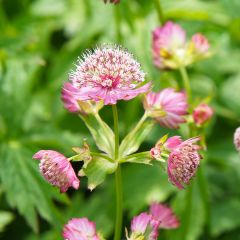
Astrantia major Rosea - Masterwort
- Flowering time July to October
- Height at maturity 60 cm
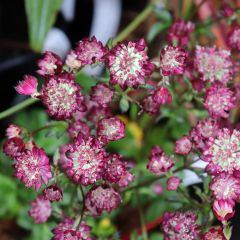
Astrantia Moulin Rouge
- Flowering time July to October
- Height at maturity 60 cm
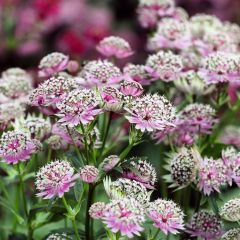
Astrantia major Buckland - Great Masterwort
- Flowering time July to October
- Height at maturity 60 cm
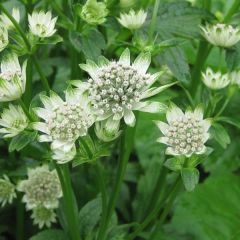
Astrantia major Star of Billion - Masterwort
- Flowering time July to October
- Height at maturity 70 cm
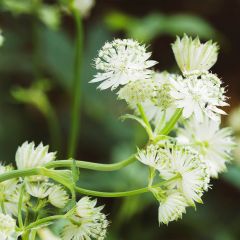
Astrantia major 'Alba'
- Flowering time July to October
- Height at maturity 60 cm
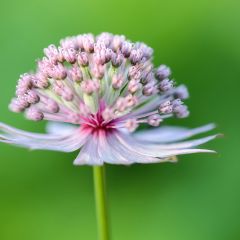
Astrantia major - Great Masterwort
- Flowering time July to October
- Height at maturity 90 cm
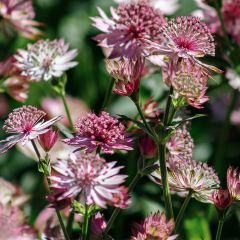
Astrantia major 'Roma'
- Flowering time July to October
- Height at maturity 60 cm
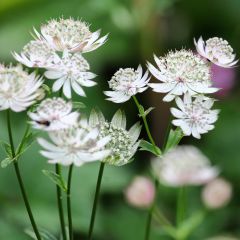
Astrantia major Shaggy - Masterwort
- Flowering time July to October
- Height at maturity 60 cm
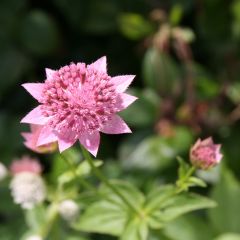
Astrantia maxima
- Flowering time July to October
- Height at maturity 40 cm
Discover other Astrantia - Masterwort
View all →Available in 0 sizes
Available in 0 sizes
Available in 3 sizes
Available in 2 sizes
Available in 1 sizes
Available in 2 sizes
Available in 2 sizes
Available in 0 sizes
Available in 2 sizes
Available in 2 sizes
Young plantation
Where to plant Astrantia?
It grows well throughout France, except by the sea (Astrantia cannot tolerate soil salinity), in Mediterranean climates, and in areas with sandy or stony soil.
Astrantia prefers to be planted in partial shade, typically with a few hours of morning sun (east) or late afternoon sun, or under dappled sunlight filtered by trees.
It can tolerate full sun (except in southern regions) as long as the soil remains cool in summer without drying out. However, we recommend planting it where it will look its best: sheltered from the scorching sun in the partial shade of a hedge or under the light shade of a tree.
It thrives in deep, cool, rich, heavy, or well-drained soils: typically, a good potting mix, rich clay soil, or woodland soil. It is not very sensitive to soil acidity (neutral, acidic, or calcareous), and it tolerates a variety of soil types, except for very poor and draining soils (very sandy or very stony), where it tends to dry out in summer. In such cases, flowering may stop, and the foliage may partially dry out. It generally resumes growth with autumn rains, but prolonged drought can be fatal.
It prefers well-drained soil. Therefore, if your soil is very heavy, it is better to plant it on a gently sloping area or to add potting mix at planting.
From its montane origins, Astrantia has retained a beautiful hardiness. It can withstand temperatures below -15°C without any issues. Thus, it is not afraid of cold climates.
A very windy location does not harm flowering but tends to damage the foliage, which may partially blacken and become less attractive: it is better to place it in a sheltered spot away from strong winds.
Pot cultivation is not recommended: as it prefers coolness and deep soil, it struggles to thrive in a confined environment, much like a peony, for example. However, from experience, it is possible to succeed in a sufficiently deep container, at least 20 cm, in a fairly shaded position, while monitoring summer watering.
When to plant?
Astrantia can be planted throughout the year, preferably during cooler and well-watered periods, avoiding times of heavy frost: from September to November in autumn, and from March to May in spring.
How to plant?
Prepare the soil by digging a hole about twenty centimetres deep and wide. Crumble the soil well.
If your soil is challenging (stony, sandy, or very heavy), mix a few litres of potting mix into your planting soil and add a base amendment or a nitrogen-rich perennial plant fertiliser (crushed horn, without drying out).
 Planting Astrantia
Planting Astrantia
Water thoroughly at planting to eliminate air pockets; monitor watering closely for a month after planting, ensuring the soil does not dry out. During the first summer, be attentive to watering once or twice a week during dry spells. In subsequent years, no watering will be necessary unless there is marked drought or planting in full sun.
Plant 4 to 5 plants per m2, spaced 30 to 40 cm apart. At maturity, one plant is sufficient to create a lovely effect in a border, but it is often preferable to plant in numbers (5 or 7 plants) for a spectacular display.
Maintenance
Rarely targeted by pests, Astrance is a very robust plant. In spring, the young shoots are sometimes attacked by slugs. Protect them, preferably with an organic slug deterrent (wood ash, lava powder, or ferramol, for example).
Astrance is not susceptible to diseases: it may occasionally be attacked by aphids or powdery mildew, but generally without serious damage.
If the soil tends to dry out in summer, mulch at the end of spring to maintain some moisture at the base (see our article on summer mulching here); however, winter mulching encourages slug proliferation.
Cut the flower stems as they dry to promote the emergence of new leaves.
In autumn or preferably at the end of winter, you can cut the dry vegetation back to the ground.
Multiplication
Sowing Astrantias
You can reseed the seeds you produce as soon as the stems have dried… or buy them in packets.
You can sow directly in place, in the garden, but it is advisable to sow in trays, as the results are better.
Even in pots, sowing Astrantias remains, in most cases, a relatively complex and uncertain operation for experienced gardeners: the seeds need a period of cold (cold stratification) to germinate well. Germination takes 6 to 8 weeks under controlled temperature and watering.
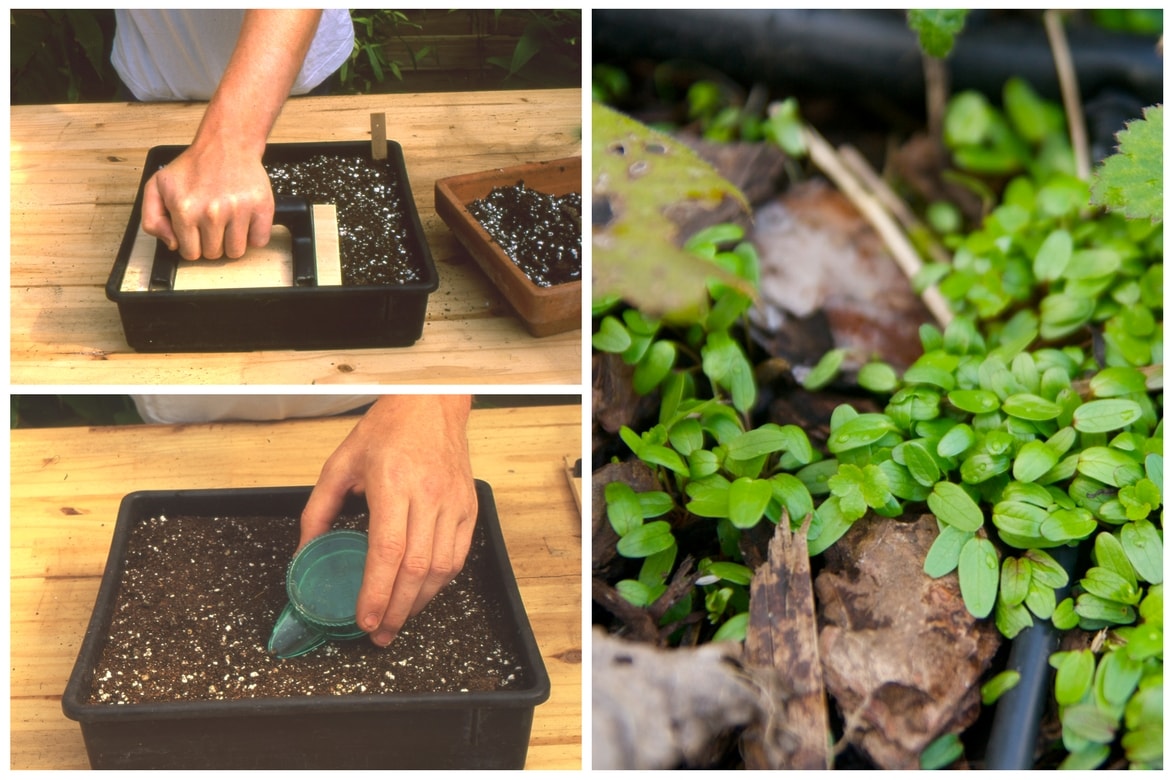
Sowing Astrantia
Dividing Astrantias
In contrast to sowing, dividing Astrantias is easy and risk-free. It is an excellent method for mass planting. Divide sufficiently robust plants, generally after 4 years of cultivation, then every two years. This will indefinitely extend their lifespan.
In early spring, before the first leaves start to emerge (late February or March), dig up the stump using a spade. With the spade blade, or using a saw or a large knife, divide the stump into 3 to 5 pieces depending on its size, and replant immediately, spacing each stump at least 30 cm apart.

First cut with the spade into as many pieces as needed, then gently separate the stumps by hand and replant.
Association
Astrance pairs well, and even very well, with a multitude of varieties of plants. It plays a role in the garden similar to that of the “little black dress” in a woman’s wardrobe: it is inserted into various styles of flower beds, invariably adding a touch of elegance, with no risk of bad taste.
It is a classic perennial that is essential in English gardens, where it can be found in white/pink/blue combinations with other perennials. It is prized in contemporary meadow gardens. It is a nearly universal solution for dressing the base of a rosebush, a bush, or a hedge. And of course, it is one of the centrepieces of shade gardens and white gardens.
Astrances also make very beautiful bouquets, thanks to their long stems. Cut flowers remain beautiful for 2 to 3 weeks and can also create lovely dried bouquets: simply allow the cut stems to dry for a few days, upside down. They pair particularly well with roses, and with wildflowers for a rustic bouquet, or with the foliage of Alchemilles or Heuchères for a romantic bouquet.
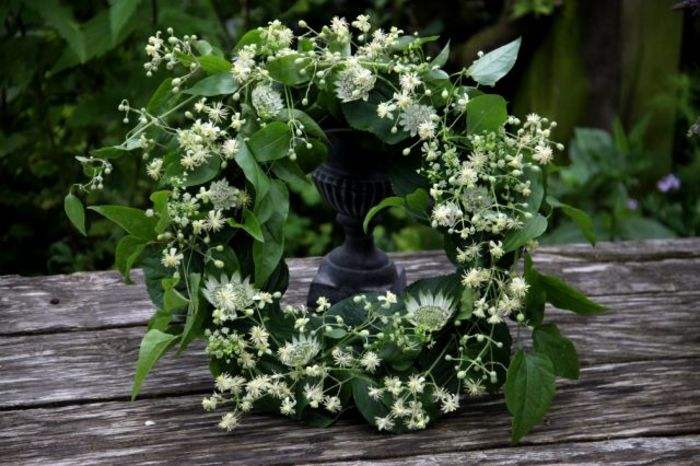
Floral crown composed of Shaggy Astrance flowers and Clematis vitalba – Isabelle Olikier
Useful resources
- The most beautiful range of astrantias in France is with us
- A good article by the famous landscaper Didier Willery in the friend of Gardens
- A synthesis of growing conditions,
- Some beautiful associations with Astrantias
- Astrantias, the largest umbels
- Our advice sheet: Mulching, why and how
- Our advice video: How to plant alpines in rockeries
- Our advice sheet: Choosing an Astrantia
- Our advice sheets: White-flowered Astrantias and Pink-flowered Astrantias
- Discover Olivier’s favourite: The astrantias
Frequently asked questions
-
My Astrantia isn't growing... or hardly at all. What should I do?
Be patient, it’s normal! Slow to grow (which explains the relatively high price of young plants in the market), Astrance is quite lazy to establish: often, the beginner gardener is disappointed to see their young plants, planted in spring, remain relatively weak and poor in flowers during the first year: adding fertiliser at planting helps them get started… and then patience! The explosion of flowers from the second year will reward them.
-
My Astrantia isn't flowering, what should I do? My Astrantia stopped flowering in July, is that normal?
It's not normal. An Astrantia typically flowers from May or June to September. It must be lacking water.
If it isn't flowering, it's usually because it's short of water: soil that's too dry, draining, or sunny, or a combination of these causes. The remedy is simple: mulch... and water regularly! Another possible cause is planting in a spot that's too dark, with dense shade and no sunlight at all. It should then be moved, at the end of winter, to a semi-shaded area. Sometimes, a shortened flowering period is observed: from July onwards, flowering slows down and stops in mid-summer: 99 times out of 100, the cause is lack of water: soil that's too dry, draining, or sunny.
Note: cutting back spent flower stems helps to extend the flowering period by encouraging the emergence of new flowers.
-
I sowed Astrantia seeds. The colour is different from what I expected. Is this normal?
Yes. Sowing is never homogeneous, and differences in colour, sometimes noticeable, are inevitable. Dividing the clumps, on the other hand, preserves the exact shades of the flowers from the mother plant.
-
The leaves of my Astrantia are half dry. What should I do?
It's not pretty... but that's alright. It probably got thirsty, or suffered from a drying wind. Water if the soil is dry. And of course, in autumn, it's inevitable as the deciduous foliage of Astrantia disappears in winter: it gradually dries out from September-October onwards.
- Subscribe!
- Contents
